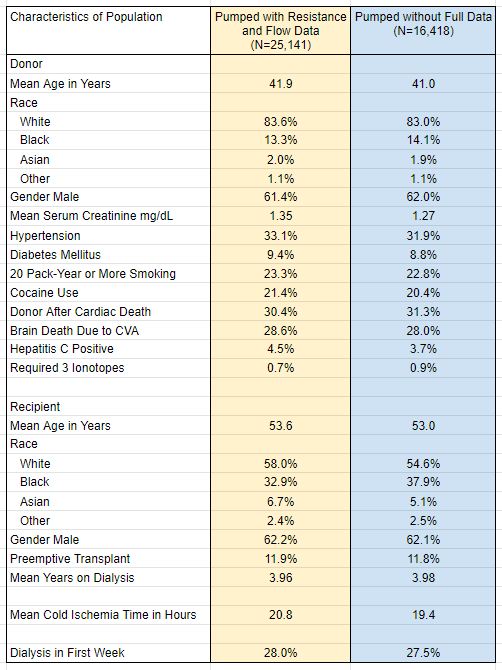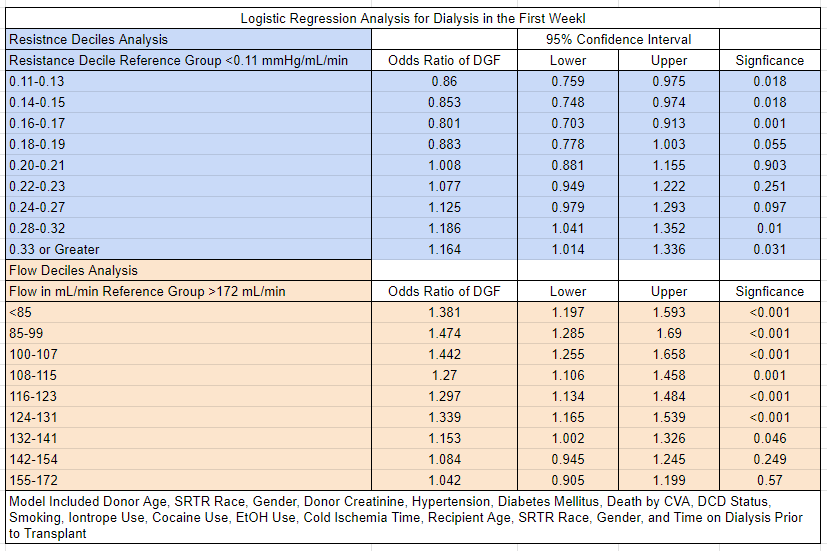Final Flow and Resistance with Cold Pulsatile Perfusion Preservation Are Independent Risk Factors for Dialysis in the First Week Post-Transplant, Analysis of SRTR Data
Kidney Transplant, Ascension Sacred Heart Hospital, Pensacola, FL
Meeting: 2022 American Transplant Congress
Abstract number: 444
Keywords: Cadaveric organs, Ischemia, Kidney transplantation, Pulsatile preservation
Topic: Clinical Science » Organ Inclusive » 69 - Non-Organ Specific:Organ Preservation/Ischemia Reperfusion Injury
Session Information
Session Name: Surgical Issues: Donor and Recipient
Session Type: Rapid Fire Oral Abstract
Date: Tuesday, June 7, 2022
Session Time: 3:30pm-5:00pm
 Presentation Time: 4:50pm-5:00pm
Presentation Time: 4:50pm-5:00pm
Location: Hynes Room 310
*Purpose: To determine if final flow or resistance on cold pulsatile perfusion preservation (CPPP) have independent predictive value for dialysis in the first week post-transplant.
*Methods: All deceased donor kidneys with donor age greater than 12 who received CPPP and who had data on final flow and resistance recorded were identified from 1/1/2010 until 9/2/2020. Delayed graft function (DGF) was defined as the need for dialysis in the first week post-transplant. Logistic regression was used to determine the independent effect of final resistance or flow on DGF.
*Results: Of the 41,559 deceased donor kidney transplants receiving CPPP in this time period. 25,141 had final pump flow and resistance data and were included in the study. The characteristics of the pumped deceased donors that had missing data for pumping parameters were very similar suggesting little selection bias.
Binary logistic regression for DGF showed that 6 deciles associated with lower flow were associated with increased risk of DGF while only the top two deciles of resistance were associate with increased risk of DGF.
The low resistance analysis showed a slight U shape with the deciles of resistance just above the reference having lower risk of DGF. When flow or resistance were added to the model as continuous variables the association between flow or resistance and DGF strengthen indicating that more outlying values have even higher risk of DGF.
*Conclusions: Low flow and high resistance were both associated higher rates of DGF after adjusting for other covariates. Extreme outliers of low flow (<75mL/min) and high resistance (>1.0 mmHg/mL/min) appear to have a high risk for DGF. Awareness of these variables effect on DGF can help dialysis planning in the immediate post-transplant period.
To cite this abstract in AMA style:
Keith DS, Lessmann E. Final Flow and Resistance with Cold Pulsatile Perfusion Preservation Are Independent Risk Factors for Dialysis in the First Week Post-Transplant, Analysis of SRTR Data [abstract]. Am J Transplant. 2022; 22 (suppl 3). https://atcmeetingabstracts.com/abstract/final-flow-and-resistance-with-cold-pulsatile-perfusion-preservation-are-independent-risk-factors-for-dialysis-in-the-first-week-post-transplant-analysis-of-srtr-data/. Accessed December 27, 2025.« Back to 2022 American Transplant Congress



